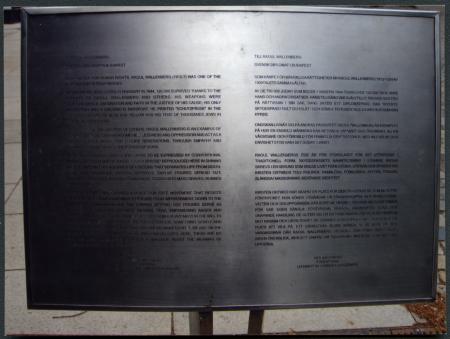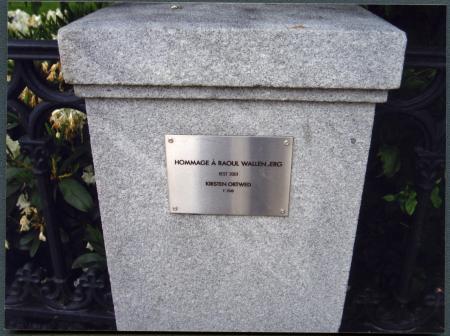Obj. ID: 13353
Modern Jewish Art Raoul Wallenberg Monument in Stockholm, Sweden, 2001

Memorial Name
Hommage à Raoul Wallenberg
Who is Commemorated?
Raoul Wallenberg, one of the Righteous Among the Nations
Description
This memorial, in a public square along Nybroviken Bay, consists of 13 bronze sculptures. 12 of these are human figures, roughly cast so as to make them featureless and crudely shaped, dressed in rags and in various degrees of collapse. The thirteenth, in front of these figures, is a copy of Raoul's signature in bronze on the ground, representing his signature on passports that saved lives.
Nearby is a stone orb [Photo needed], with Wallenberg's name and an inscription, set between pieces of a black metal fence, and an informational plaque with inscriptions in English and Swedish. Before the orb was at the location, it seems a stone block with a metal plaque stood in its place [confirmation needed]
Inscriptions
Orb
[To be photographed and transcribed]
Informational Plaque
Swedish
Till Raoul Wallenberg
Svensk Diplomat i Budapest
Som kämpe för mänskliga rättigheter är Raoul Wallenberg (1912-?) enav
1900-talets sanna hjältar.
Av de 750 000 Judar som bodde i ungern 1944 överlevde 120 000 tack vare
hans och andras insatser hans tillgand var självtillit, fantasi och tro
pa rattvisan i sin sak, hands skydd ett diplomatpass. Han tryckte
skyddspass i gult och blat: tiotusentals Judar i hus som han
hydre.
Ondskan livnär sig pa andras passivitet. Raoul Wallenberg ar exemplet
pa hur en enskild manniska kan betvinga vanmakt och overmacht, bli en
vägvisare och förebild dör framtida generation med inlevelse och
envishet stod han i det godas tjanst.
Raoul Wallenberg öde är för storslaget för att uttryckas i
traditionell form. Skyddspassets namnteckning i lysande brons
skrevs i en sekund som skilde livet dönen, utifran den sprider sig
Kirsten Ortweds tolv figurer, namnlosa, forkladda, bylten, trasor,
slangdai massgravar, berövade identitet.
Kirsten Ortwed har skapat en plats for den fria rorelse sommotstar
fortrycket. Hon soker utgangar ur fangenskapen, mot nybroviken
vatten och soluppgangen dar bottom. Hennes figutrt ar guutformar
for var egen kansla: fortvivlan, skrack, dadkraftig, ilska, och
skapande handling, se sliter sig ur en tung massa i en vilja att gripa in
mot rasism och likgiltighet. De gommer ocksa nagot milt och stilla en
plats att vila pa, ett gangstrak bland manga, vi ar nere pa den
vardagsniva dar Raoul Wallenberg vistades. Dar Finns inget facit
ingen overblick, men ett samtal om tillvarons innebord som inte far
upphora.
Per Wästberg
Forfattare
Ledamot Av Svenska Akademien
English
To Raoul Wallenberg
Swedish Diplomat in Budapest
As a fighter for human rights, Raoul Wallenberg (1912-?) was one of the
20th century's true heroes.
Of the 750,000 Jews living in Hungary in 1944, 120,000 survived thanks to the
actions of Raoul Wallenberg and others. His weapons were
self-confidence, imagination, and faith in the justice of his cause; his only
protection was a diplomatic passport. He printed "Schutpässe" in the
Swedish colours of blue and yellow and had tens of thousands Jews in
houses rented by him.
Evil thrives on the inaction of others, Raoul Wallenberg is an example of
how an individual can overcome helplessness and oppression and act as a
guide and role model for future generations. Through empathy and
determination he served the forces of good.
Raoul Wallenberg's fate is too large to be expressed by conventional
means. The signature of those "Schutzpässe" reproduced here in
shining bronze, was written in a space of a second that separated life from death.
From that signature, Kirsten Ortwed's twelve figures spread out,
nameless, disguised, in bundles and rags, tossed into mass graves, robbed
of their identity.
Kirsten Ortwed has created a place for free movement that resists
tyranny. She is searching ways to escape from imprisonment, down to the
waters of Nybroviken and the sunrise beyond. Her figures serve as
moulds for our own feelings: despair, fear, empowering anger and
creative action. They tear themselves out from a heavy mass in the will to
fight racism and indifference. They also conceal something gentle and
tranquil: a place to rest, a passageway among many others. We are on the
same everyday level where Raoul Wallenberg lived. Here, there are no
set answers, no overview. Rather a dialogue about the meaning of
existence that must not cease.
Per Wästberg
Author
Member of the Swedish Academy
Commissioned by
The City of Stockholm and the National Public Art Council
sub-set tree:
Sculptures are between 27 cm and 86 cm in height, between 1.8 m and 3.4 m in length, and between 40 cm and 55 cm in width (Schult, p. 358)
A selection committee decided on Kirsten Ortwed proposal in November 1998.
The National Public Art Council financed the monument.
The monument was unveiled on August 24, 2001, by King Carl XVI Gustaf of Sweden.
"Memorial Raoul Wallenberg Stockholm" Traces of War, https://www.tracesofwar.com/sights/8949/Memorial-Raoul-Wallenberg-Stockholm.htm (accessed July 12, 2023)
Schult, Tanja, A Hero’s Many Faces: Raoul Wallenberg in Contemporary Monuments. (New York: Palgrave Macmillan, 2012), pp. 233-255, 357-360.









